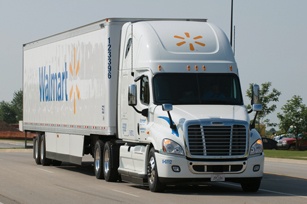Wal-Mart Uses Private Fleet to Push Service, Expense, Green Goals
by May 16, 2011 12:00 am 406 views

The power of Wal-Mart Stores Inc. corresponds with its size as the world’s largest retailer. This power has been dubbed “the Wal-Mart effect.”
And when it comes to transportation issues, the Bentonville-based company has “enormous influence and an enormous ability to negotiate to terms and set the standard,” said Leon Nicholas, senior vice president of Kantar Retail, a consulting firm based in Cambridge, Mass.
Wal-Mart has the fourth-largest private fleet of trucks in the U.S., according to Transport Topics, the industry weekly published by the American Trucking Associations.
As senior vice president of transportation services for Wal-Mart, Chris Sultemeier oversees all Wal-Mart domestic transportation as well as the fleet.
The company’s trucks transport goods from its distribution centers to Wal-Mart’s 4,000 U.S. and Sam’s Club warehouse stores. The fleet, Sultemeier said, has a three-fold mission: to provide a high level of service to Wal-Mart’s stores, to keep costs down and to further the company’s environmental sustainability goals.
“From a service standpoint, we have an on-time delivery expectation of over 99 percent, so by having a captive private fleet, then we can ensure that that service metric is hit,” Sultemeier said.
Cost control and sustainability are intertwined, he added. The transportation division’s laser-like focus on efficiency results in a reduction in both “empty miles” – meaning a truck on the road with no cargo – and in fuel use. That, in turn, results in reduced carbon emissions.
Wal-Mart initiated its sustainability program in 2005. The program has three objectives: for renewable energy to provide 100 percent of the energy used by the company, for Wal-Mart to create zero waste and for it to sell products that “sustain people and the environment.”
An example of Wal-Mart’s commitment to sustainability in its transportation division is its partnership with Daimler Trucks North America to build a hybrid-electric Freightliner Cascadia.
In its 2011 “Global Responsibility Report,” Wal-mart said its U.S. operation “continues to drive toward its goal of doubling fleet efficiency, realizing a 65 percent improvement in 2010 over our 2005 baseline.”
During the past two years, according to Wal-Mart, it has replaced nearly two-thirds of its fleet with more efficient tractors and bought 3,000 skirted trailers (wind skirts are believed to reduce wind resistance) to improve fleet efficiency.
Last year, the company “delivered 57 million more cases, while driving 49 million fewer miles,” the report said. “This equates to avoiding almost 40,000 metric tons of CO2 emissions, which is the equivalent of taking 7,600 cars off the road.”
A year ago, Wal-Mart began a program to gain more control over transportation from its suppliers to its stores. It started working with suppliers, of which it has thousands, to take over deliveries to Wal-Mart’s distribution centers in cases in which the retailer had determined that it could do the job more cheaply.
The program works like this:
A Wal-Mart truck delivers loads from the company’s distribution center in Searcy, for example, to its stores in another part of Arkansas.
After making its delivery, the truck stops by a vendor’s facility and picks up a load headed for the Searcy distribution center.
“That reverse process of taking a load out to a store and then bringing back another load to the distribution center is what we call a back-haul,” Sultemeier says. “Well, because we have this huge network of suppliers … we have the opportunity to reduce empty miles.”
Jim Crowell, director of the Supply Chain Management Research Center at the University of Arkansas, said the inbound logistics initiative isn’t uncommon.
Crowell, who previously worked for Coors Brewing Co. of Golden, Colo., said, “As far back as 1980 we were looking at our inbound [shipments] as well as our outbound” in an effort to control costs.
Some suppliers met Wal-Mart’s plan with skepticism, as did some for-hire trucking companies. The suppliers feared they would lose economies of scale if they let Wal-Mart take over their shipping; the truckers feared they would lose freight.
But Nicholas, the Kantar Retail consultant, said the program hasn’t been widespread enough to produce a discernable effect on trucking companies. Crowell said Wal-Mart is good at managing its supply chain and “part of the reason they’re good at it is because they collaborate very well with their suppliers.”
Efficiency Is Key
Ultimately, the name of the game is efficiency. And rising fuel costs cause Wal-Mart to seek even greater efficiencies.
Sultemeier said higher fuel prices are both a challenge and an opportunity for the transportation division. The challenge is to the bottom line.
The opportunity, Sultemeier said, lies in “the complexity and the efficiency of our supply chain.”
“We can leverage that network to actually comparatively operate more efficiently and take costs out compared to other retailers,” Sultemeier said.
“At the end of the day our focus and our goal is to be able to provide goods at a lower price, to sell for less. That’s why the supply chain at Wal-Mart is just integral to operating in an ‘everyday low price’ environment.”
Crowell noted that the company recently held a sustainability event.
“And Wal-Mart’s private fleet actually is advertising – they’re almost in effect becoming a sales agent – saying, ‘Look, I would like to sell you some of my empty miles,'” Crowell said.
“It’s pretty innovative stuff. They’re looking at the whole package. They’re saying, ‘I’ve got this fleet. I want to utilize this as much as I can.'”
